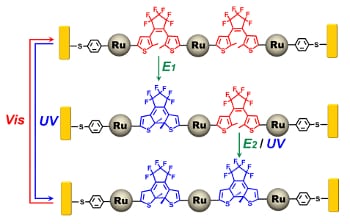Molecular transport junctions (MTJs) are an essential structures in molecular electronics, which exhibit unique advantages in synthetic tailorability, chemically controllable assembly, and highly scalable size. In addition to the study of conductivity of individual molecules, MTJs nanostructures also possess electroactive properties, which have been used in the development of functional molecular devices, such as conductors, diodes, switches, transistors, memristors and so forth. External stimuli, such as light, mechanical force, magnetic field, electrical field and electrochemical potential, are all driving forces that can modulate the structure or the conformation of molecules, and therefore affect the performance of these molecular devices. The open question now is whether the synergies between these external stimuli and corresponding fabrication of multi-addressable MTJs may further efficiently advance the field of molecular electronics.

Now the first photo/electro co-modulation of MTJs based on chemically fabricated nanogaps functionalized with organometallic complexes has been achieved with the international and interdisciplinary collaboration by researchers from Nanyang Technology University, Singapore, and University of Rennes 1, France. As reported in Nature Communications, the researchers have demonstrated the very first molecular nanodevices that perform conductive switching behavior between two distinct states by judiciously applying orthogonal optical and electrochemical stimuli, which suggests great potential for logic computing.
The orthogonally modulated nanodevice involves chemically fabricated nanogaps functionalized with organometallic ruthenium fragment-modified dithienylethene complex; the addressable and stepwise control of molecular isomerization can be repeatedly and reversibly achieved. Here, the orthogonal optical (UV/visible light irradiation) and electrochemical (electrolysis at low potential) stimuli are used to control such structural rearrangement. These multi-addressable MTJs-based nanodevices can be designed to carry out Boolean computing, such as 2-input OR and 3-input AND-OR operators. Importantly, compared with other logic gates based on chemical system, these MTJs can be simply reset by visible light, ensuring a cycled set-reset operation.
The successive switchable behaviors of the incorporated molecules within the nanogaps are all based on rational chemical design. A dithienylethene photochromic unit, which undergoes isomerization between a π-conjugated closed state and a non-conjugated open state, determines the conductivity of the nanodevice. Meanwhile, ruthenium moieties properly modulate electronic coupling between the dithienylethene moiety and gold nanoelectrodes to avoid one-way switching in the similar complex as previously reported, and guarantee the low potential electro-triggered metal-promoted electrochemical cyclisation that allows stable Au-S bond connection between the functional molecules and two nanoelectrodes. Moreover, the unique electronic structure of the longer molecule combined with two dithienylethene units offered the stepwise control.
“It is worthy to note that the progress in the emerging research field is impossible without the cross-fertilization between the chemistry, physics, biology, materials science, and engineering communities”, adds Prof. Xiaodong Chen of Nanyang Technological University, the corresponding author of the paper, “the achievement of the molecular device shows a good example to exploit functional electronic nanocircuits for complex computing by relying on the advanced techniques of chemistry”.
The first author of the paper, Mr. Fanben Meng, a Ph.D. student from Prof Chen’s group, looks ahead: “It is exciting to foresee the precise control of molecular behavior at nanoscale and we believe that rational molecular design can provide us a solid platform for the development of multifunctional electronic devices after optimizing fabrication and operative conditions.”

















